MGT723 Research Project: Analyzing Data on Climate Change Impact
VerifiedAdded on 2023/06/04
|12
|2808
|468
Project
AI Summary
This MGT723 research project delves into the crucial area of climate change, specifically focusing on the impact of carbon emissions in Africa. The project begins with an introduction to climate change, referencing the UNFCCC definition and highlighting the vulnerability of Africa to rising temperatures. It includes a summary of the literature review, emphasizing the reliance of African economies on agriculture and the potential threats posed by climate change. The conceptual model outlines the relationships between climate effects, temperature changes, rainfall patterns, and various socio-economic factors. Data collection methods, including questionnaires and interviews, are described, along with the use of descriptive and inferential statistical analysis. The project aims to determine the correlation between carbon emissions and climate change trends, utilizing both qualitative and quantitative data to support its hypotheses. Desklib provides a platform to explore this document further, offering access to related materials and study tools for students.
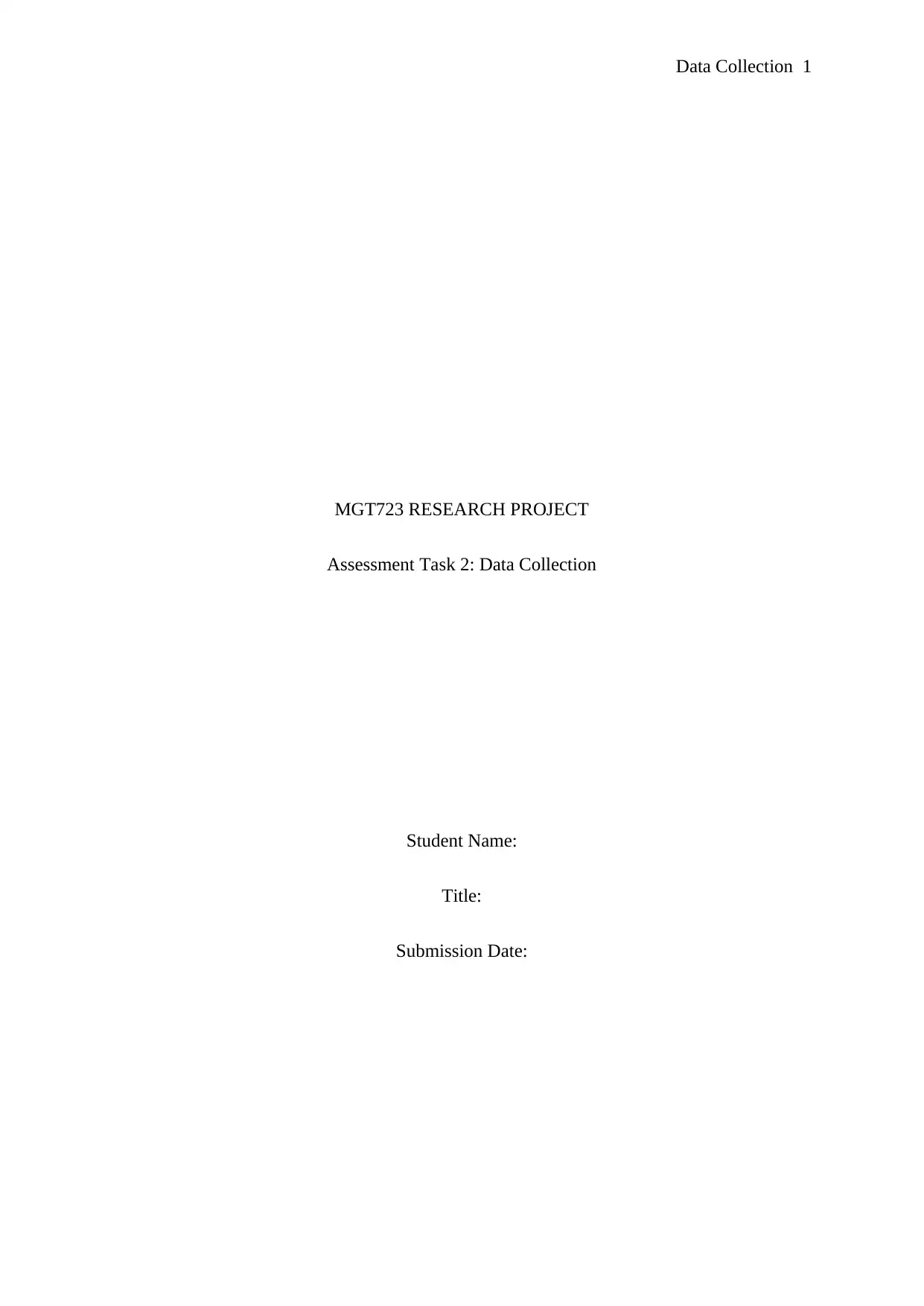
Data Collection 1
MGT723 RESEARCH PROJECT
Assessment Task 2: Data Collection
Student Name:
Title:
Submission Date:
MGT723 RESEARCH PROJECT
Assessment Task 2: Data Collection
Student Name:
Title:
Submission Date:
Paraphrase This Document
Need a fresh take? Get an instant paraphrase of this document with our AI Paraphraser

Data Collection 2
Acknowledgment
I certify that I have carefully reviewed the university’s academic misconduct policy. I
understand that writing ethics when citing other people’ the source of ideas must be
referenced, and that quotation marks and a reference are required when directly quoting
anyone else’s words.
I thank my family for their unconditional support throughout the project.
Special appreciation to my professor (insert name) for continually guiding me and standing in
as my resource person. My classmates and friends, too I thank them for their heartfelt counsel
that saw me undertake this project successfully.
Above all, I thank the Almighty God for enabling me to come this far.
Acknowledgment
I certify that I have carefully reviewed the university’s academic misconduct policy. I
understand that writing ethics when citing other people’ the source of ideas must be
referenced, and that quotation marks and a reference are required when directly quoting
anyone else’s words.
I thank my family for their unconditional support throughout the project.
Special appreciation to my professor (insert name) for continually guiding me and standing in
as my resource person. My classmates and friends, too I thank them for their heartfelt counsel
that saw me undertake this project successfully.
Above all, I thank the Almighty God for enabling me to come this far.
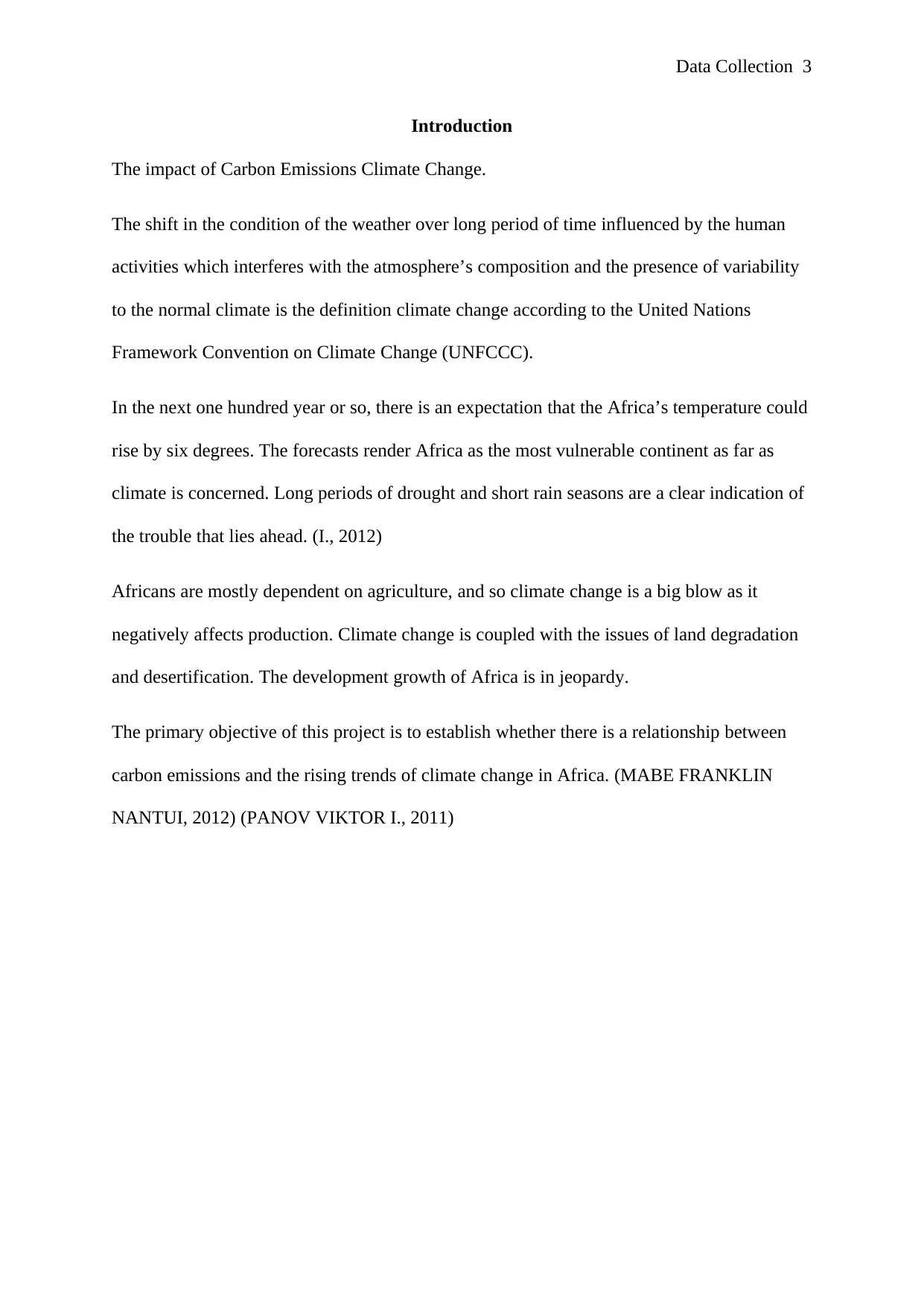
Data Collection 3
Introduction
The impact of Carbon Emissions Climate Change.
The shift in the condition of the weather over long period of time influenced by the human
activities which interferes with the atmosphere’s composition and the presence of variability
to the normal climate is the definition climate change according to the United Nations
Framework Convention on Climate Change (UNFCCC).
In the next one hundred year or so, there is an expectation that the Africa’s temperature could
rise by six degrees. The forecasts render Africa as the most vulnerable continent as far as
climate is concerned. Long periods of drought and short rain seasons are a clear indication of
the trouble that lies ahead. (I., 2012)
Africans are mostly dependent on agriculture, and so climate change is a big blow as it
negatively affects production. Climate change is coupled with the issues of land degradation
and desertification. The development growth of Africa is in jeopardy.
The primary objective of this project is to establish whether there is a relationship between
carbon emissions and the rising trends of climate change in Africa. (MABE FRANKLIN
NANTUI, 2012) (PANOV VIKTOR I., 2011)
Introduction
The impact of Carbon Emissions Climate Change.
The shift in the condition of the weather over long period of time influenced by the human
activities which interferes with the atmosphere’s composition and the presence of variability
to the normal climate is the definition climate change according to the United Nations
Framework Convention on Climate Change (UNFCCC).
In the next one hundred year or so, there is an expectation that the Africa’s temperature could
rise by six degrees. The forecasts render Africa as the most vulnerable continent as far as
climate is concerned. Long periods of drought and short rain seasons are a clear indication of
the trouble that lies ahead. (I., 2012)
Africans are mostly dependent on agriculture, and so climate change is a big blow as it
negatively affects production. Climate change is coupled with the issues of land degradation
and desertification. The development growth of Africa is in jeopardy.
The primary objective of this project is to establish whether there is a relationship between
carbon emissions and the rising trends of climate change in Africa. (MABE FRANKLIN
NANTUI, 2012) (PANOV VIKTOR I., 2011)
⊘ This is a preview!⊘
Do you want full access?
Subscribe today to unlock all pages.

Trusted by 1+ million students worldwide
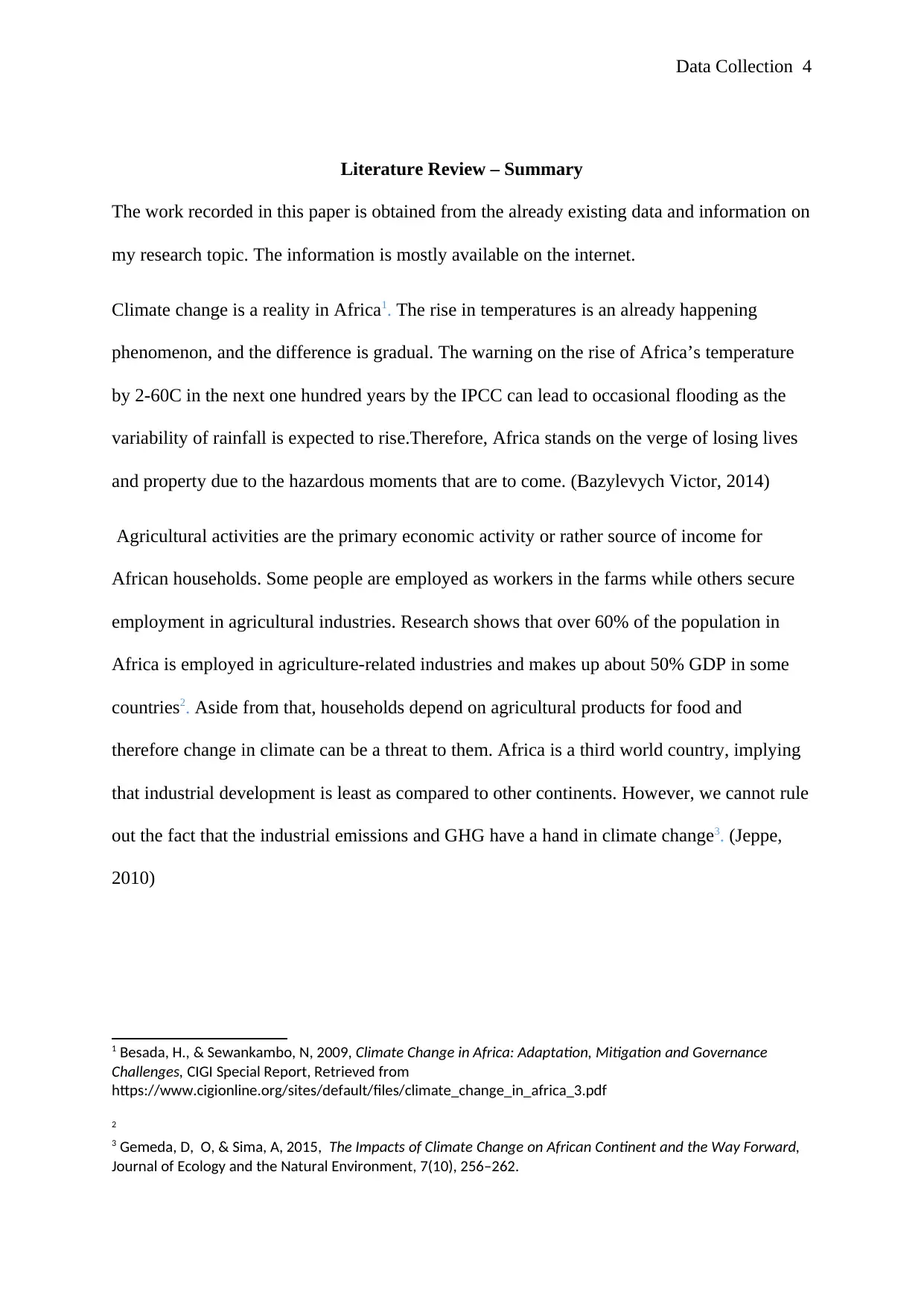
Data Collection 4
Literature Review – Summary
The work recorded in this paper is obtained from the already existing data and information on
my research topic. The information is mostly available on the internet.
Climate change is a reality in Africa1. The rise in temperatures is an already happening
phenomenon, and the difference is gradual. The warning on the rise of Africa’s temperature
by 2-60C in the next one hundred years by the IPCC can lead to occasional flooding as the
variability of rainfall is expected to rise.Therefore, Africa stands on the verge of losing lives
and property due to the hazardous moments that are to come. (Bazylevych Victor, 2014)
Agricultural activities are the primary economic activity or rather source of income for
African households. Some people are employed as workers in the farms while others secure
employment in agricultural industries. Research shows that over 60% of the population in
Africa is employed in agriculture-related industries and makes up about 50% GDP in some
countries2. Aside from that, households depend on agricultural products for food and
therefore change in climate can be a threat to them. Africa is a third world country, implying
that industrial development is least as compared to other continents. However, we cannot rule
out the fact that the industrial emissions and GHG have a hand in climate change3. (Jeppe,
2010)
1 Besada, H., & Sewankambo, N, 2009, Climate Change in Africa: Adaptation, Mitigation and Governance
Challenges, CIGI Special Report, Retrieved from
https://www.cigionline.org/sites/default/files/climate_change_in_africa_3.pdf
2
3 Gemeda, D, O, & Sima, A, 2015, The Impacts of Climate Change on African Continent and the Way Forward,
Journal of Ecology and the Natural Environment, 7(10), 256–262.
Literature Review – Summary
The work recorded in this paper is obtained from the already existing data and information on
my research topic. The information is mostly available on the internet.
Climate change is a reality in Africa1. The rise in temperatures is an already happening
phenomenon, and the difference is gradual. The warning on the rise of Africa’s temperature
by 2-60C in the next one hundred years by the IPCC can lead to occasional flooding as the
variability of rainfall is expected to rise.Therefore, Africa stands on the verge of losing lives
and property due to the hazardous moments that are to come. (Bazylevych Victor, 2014)
Agricultural activities are the primary economic activity or rather source of income for
African households. Some people are employed as workers in the farms while others secure
employment in agricultural industries. Research shows that over 60% of the population in
Africa is employed in agriculture-related industries and makes up about 50% GDP in some
countries2. Aside from that, households depend on agricultural products for food and
therefore change in climate can be a threat to them. Africa is a third world country, implying
that industrial development is least as compared to other continents. However, we cannot rule
out the fact that the industrial emissions and GHG have a hand in climate change3. (Jeppe,
2010)
1 Besada, H., & Sewankambo, N, 2009, Climate Change in Africa: Adaptation, Mitigation and Governance
Challenges, CIGI Special Report, Retrieved from
https://www.cigionline.org/sites/default/files/climate_change_in_africa_3.pdf
2
3 Gemeda, D, O, & Sima, A, 2015, The Impacts of Climate Change on African Continent and the Way Forward,
Journal of Ecology and the Natural Environment, 7(10), 256–262.
Paraphrase This Document
Need a fresh take? Get an instant paraphrase of this document with our AI Paraphraser
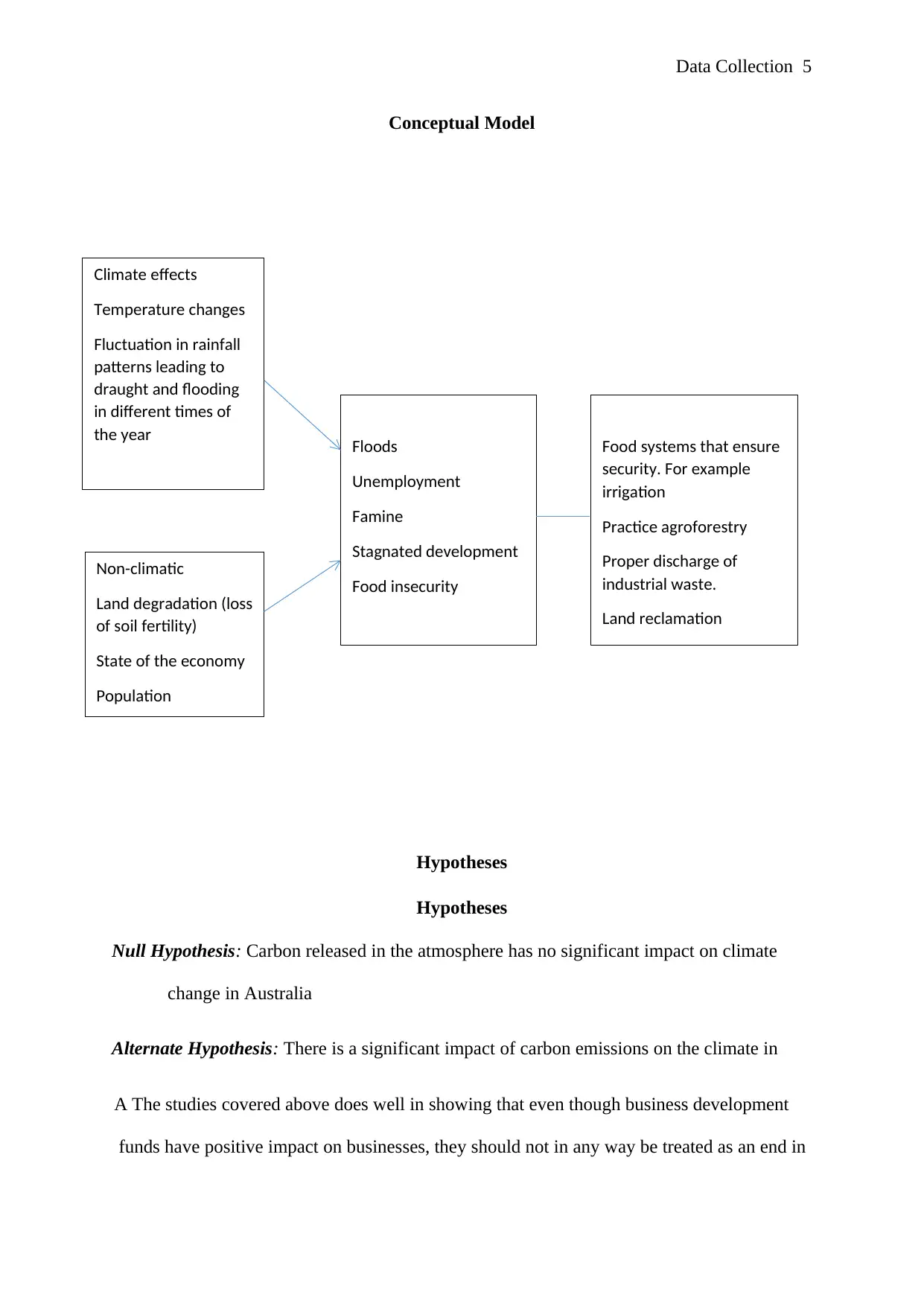
Data Collection 5
Conceptual Model
Hypotheses
Hypotheses
Null Hypothesis: Carbon released in the atmosphere has no significant impact on climate
change in Australia
Alternate Hypothesis: There is a significant impact of carbon emissions on the climate in
A The studies covered above does well in showing that even though business development
funds have positive impact on businesses, they should not in any way be treated as an end in
Climate effects
Temperature changes
Fluctuation in rainfall
patterns leading to
draught and flooding
in different times of
the year
Non-climatic
Land degradation (loss
of soil fertility)
State of the economy
Population
Floods
Unemployment
Famine
Stagnated development
Food insecurity
Food systems that ensure
security. For example
irrigation
Practice agroforestry
Proper discharge of
industrial waste.
Land reclamation
Conceptual Model
Hypotheses
Hypotheses
Null Hypothesis: Carbon released in the atmosphere has no significant impact on climate
change in Australia
Alternate Hypothesis: There is a significant impact of carbon emissions on the climate in
A The studies covered above does well in showing that even though business development
funds have positive impact on businesses, they should not in any way be treated as an end in
Climate effects
Temperature changes
Fluctuation in rainfall
patterns leading to
draught and flooding
in different times of
the year
Non-climatic
Land degradation (loss
of soil fertility)
State of the economy
Population
Floods
Unemployment
Famine
Stagnated development
Food insecurity
Food systems that ensure
security. For example
irrigation
Practice agroforestry
Proper discharge of
industrial waste.
Land reclamation
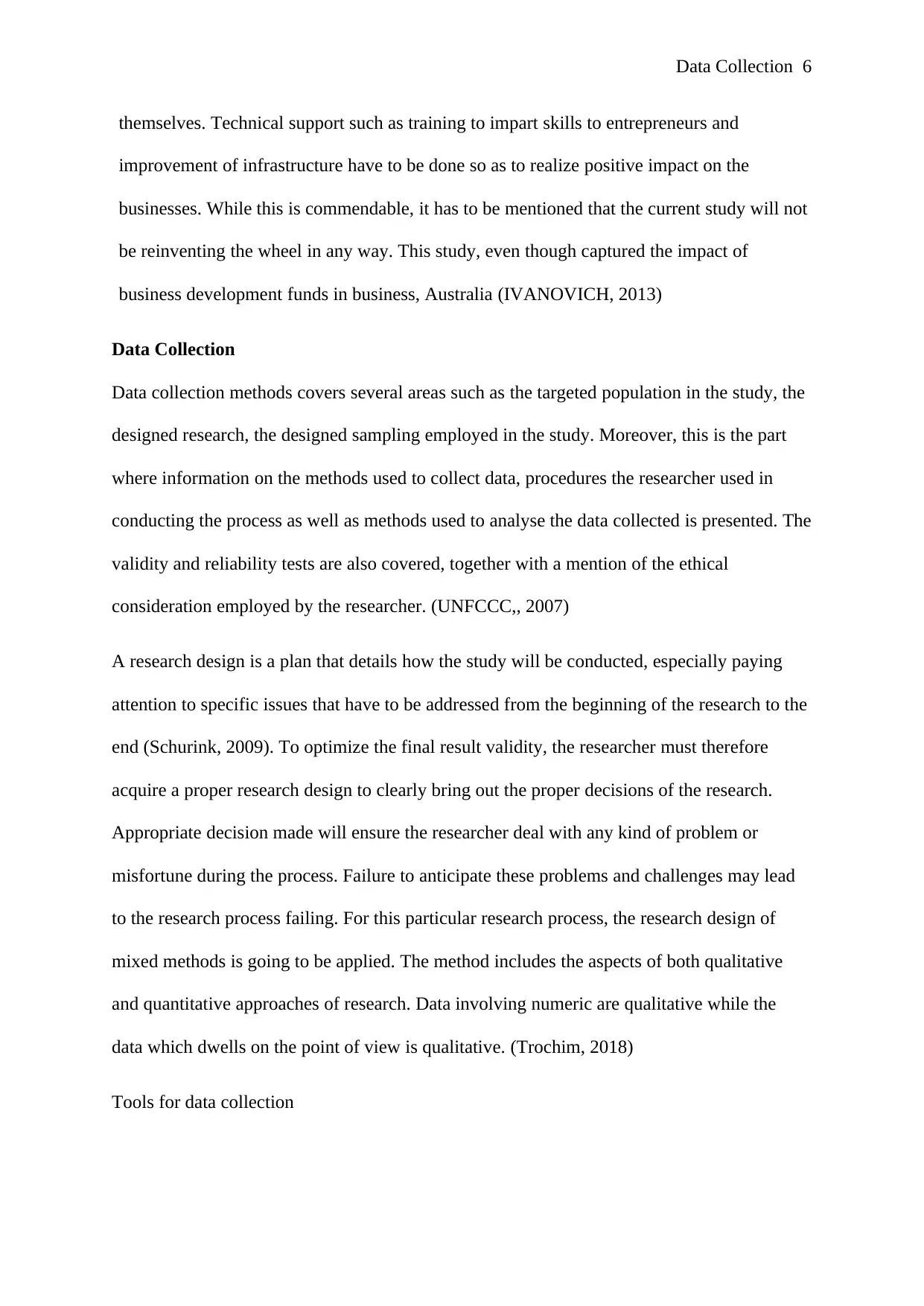
Data Collection 6
themselves. Technical support such as training to impart skills to entrepreneurs and
improvement of infrastructure have to be done so as to realize positive impact on the
businesses. While this is commendable, it has to be mentioned that the current study will not
be reinventing the wheel in any way. This study, even though captured the impact of
business development funds in business, Australia (IVANOVICH, 2013)
Data Collection
Data collection methods covers several areas such as the targeted population in the study, the
designed research, the designed sampling employed in the study. Moreover, this is the part
where information on the methods used to collect data, procedures the researcher used in
conducting the process as well as methods used to analyse the data collected is presented. The
validity and reliability tests are also covered, together with a mention of the ethical
consideration employed by the researcher. (UNFCCC,, 2007)
A research design is a plan that details how the study will be conducted, especially paying
attention to specific issues that have to be addressed from the beginning of the research to the
end (Schurink, 2009). To optimize the final result validity, the researcher must therefore
acquire a proper research design to clearly bring out the proper decisions of the research.
Appropriate decision made will ensure the researcher deal with any kind of problem or
misfortune during the process. Failure to anticipate these problems and challenges may lead
to the research process failing. For this particular research process, the research design of
mixed methods is going to be applied. The method includes the aspects of both qualitative
and quantitative approaches of research. Data involving numeric are qualitative while the
data which dwells on the point of view is qualitative. (Trochim, 2018)
Tools for data collection
themselves. Technical support such as training to impart skills to entrepreneurs and
improvement of infrastructure have to be done so as to realize positive impact on the
businesses. While this is commendable, it has to be mentioned that the current study will not
be reinventing the wheel in any way. This study, even though captured the impact of
business development funds in business, Australia (IVANOVICH, 2013)
Data Collection
Data collection methods covers several areas such as the targeted population in the study, the
designed research, the designed sampling employed in the study. Moreover, this is the part
where information on the methods used to collect data, procedures the researcher used in
conducting the process as well as methods used to analyse the data collected is presented. The
validity and reliability tests are also covered, together with a mention of the ethical
consideration employed by the researcher. (UNFCCC,, 2007)
A research design is a plan that details how the study will be conducted, especially paying
attention to specific issues that have to be addressed from the beginning of the research to the
end (Schurink, 2009). To optimize the final result validity, the researcher must therefore
acquire a proper research design to clearly bring out the proper decisions of the research.
Appropriate decision made will ensure the researcher deal with any kind of problem or
misfortune during the process. Failure to anticipate these problems and challenges may lead
to the research process failing. For this particular research process, the research design of
mixed methods is going to be applied. The method includes the aspects of both qualitative
and quantitative approaches of research. Data involving numeric are qualitative while the
data which dwells on the point of view is qualitative. (Trochim, 2018)
Tools for data collection
⊘ This is a preview!⊘
Do you want full access?
Subscribe today to unlock all pages.

Trusted by 1+ million students worldwide
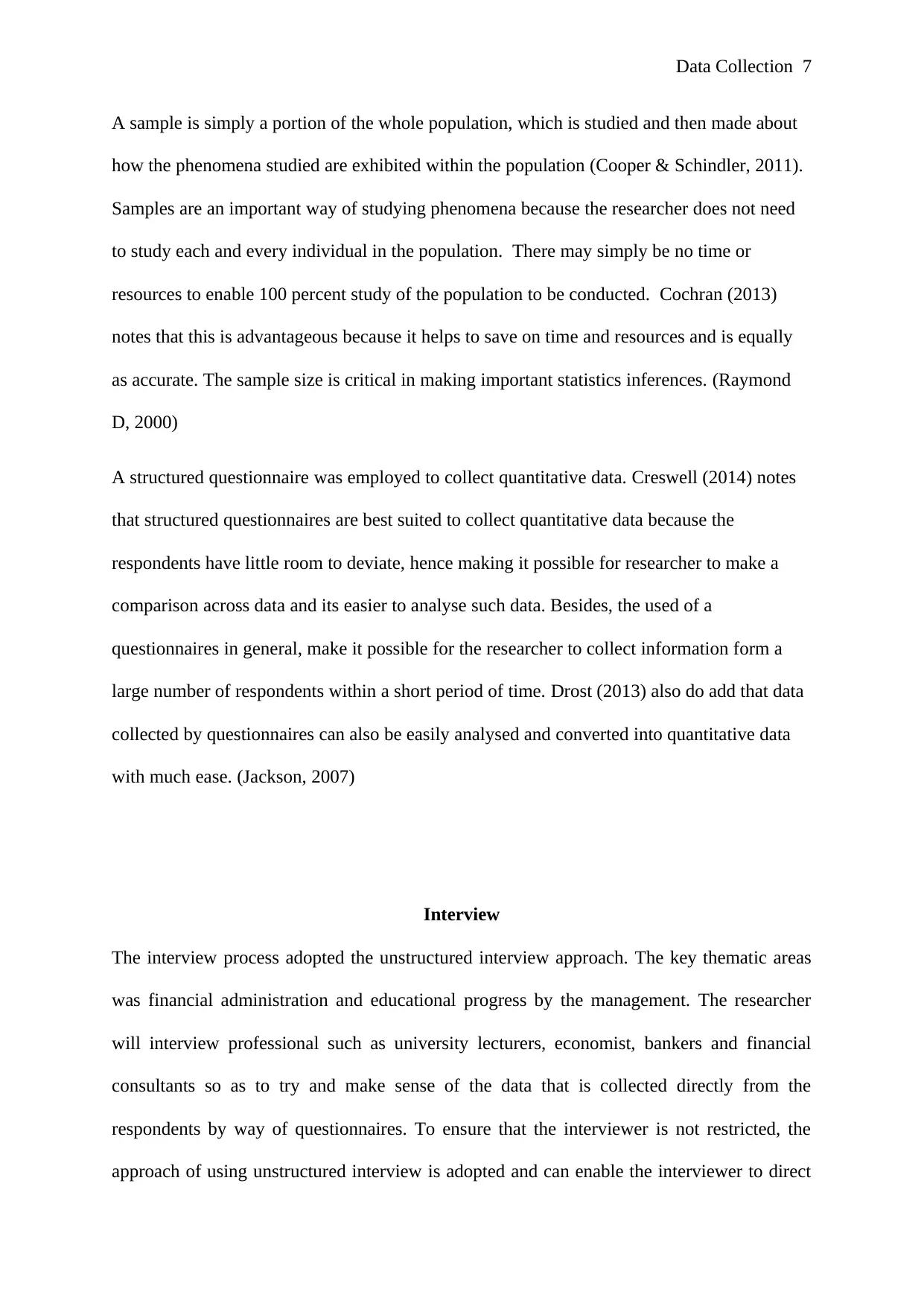
Data Collection 7
A sample is simply a portion of the whole population, which is studied and then made about
how the phenomena studied are exhibited within the population (Cooper & Schindler, 2011).
Samples are an important way of studying phenomena because the researcher does not need
to study each and every individual in the population. There may simply be no time or
resources to enable 100 percent study of the population to be conducted. Cochran (2013)
notes that this is advantageous because it helps to save on time and resources and is equally
as accurate. The sample size is critical in making important statistics inferences. (Raymond
D, 2000)
A structured questionnaire was employed to collect quantitative data. Creswell (2014) notes
that structured questionnaires are best suited to collect quantitative data because the
respondents have little room to deviate, hence making it possible for researcher to make a
comparison across data and its easier to analyse such data. Besides, the used of a
questionnaires in general, make it possible for the researcher to collect information form a
large number of respondents within a short period of time. Drost (2013) also do add that data
collected by questionnaires can also be easily analysed and converted into quantitative data
with much ease. (Jackson, 2007)
Interview
The interview process adopted the unstructured interview approach. The key thematic areas
was financial administration and educational progress by the management. The researcher
will interview professional such as university lecturers, economist, bankers and financial
consultants so as to try and make sense of the data that is collected directly from the
respondents by way of questionnaires. To ensure that the interviewer is not restricted, the
approach of using unstructured interview is adopted and can enable the interviewer to direct
A sample is simply a portion of the whole population, which is studied and then made about
how the phenomena studied are exhibited within the population (Cooper & Schindler, 2011).
Samples are an important way of studying phenomena because the researcher does not need
to study each and every individual in the population. There may simply be no time or
resources to enable 100 percent study of the population to be conducted. Cochran (2013)
notes that this is advantageous because it helps to save on time and resources and is equally
as accurate. The sample size is critical in making important statistics inferences. (Raymond
D, 2000)
A structured questionnaire was employed to collect quantitative data. Creswell (2014) notes
that structured questionnaires are best suited to collect quantitative data because the
respondents have little room to deviate, hence making it possible for researcher to make a
comparison across data and its easier to analyse such data. Besides, the used of a
questionnaires in general, make it possible for the researcher to collect information form a
large number of respondents within a short period of time. Drost (2013) also do add that data
collected by questionnaires can also be easily analysed and converted into quantitative data
with much ease. (Jackson, 2007)
Interview
The interview process adopted the unstructured interview approach. The key thematic areas
was financial administration and educational progress by the management. The researcher
will interview professional such as university lecturers, economist, bankers and financial
consultants so as to try and make sense of the data that is collected directly from the
respondents by way of questionnaires. To ensure that the interviewer is not restricted, the
approach of using unstructured interview is adopted and can enable the interviewer to direct
Paraphrase This Document
Need a fresh take? Get an instant paraphrase of this document with our AI Paraphraser
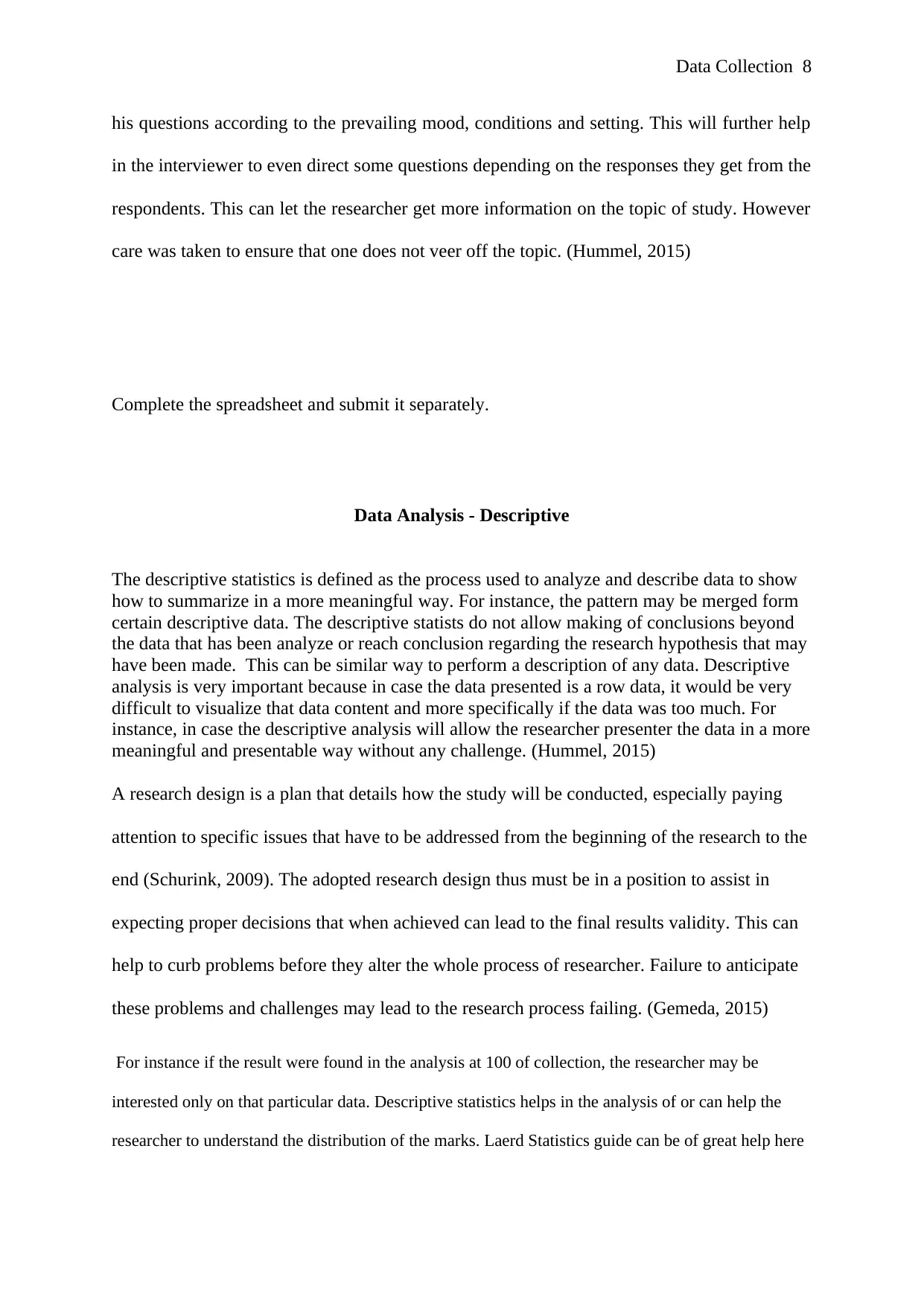
Data Collection 8
his questions according to the prevailing mood, conditions and setting. This will further help
in the interviewer to even direct some questions depending on the responses they get from the
respondents. This can let the researcher get more information on the topic of study. However
care was taken to ensure that one does not veer off the topic. (Hummel, 2015)
Complete the spreadsheet and submit it separately.
Data Analysis - Descriptive
The descriptive statistics is defined as the process used to analyze and describe data to show
how to summarize in a more meaningful way. For instance, the pattern may be merged form
certain descriptive data. The descriptive statists do not allow making of conclusions beyond
the data that has been analyze or reach conclusion regarding the research hypothesis that may
have been made. This can be similar way to perform a description of any data. Descriptive
analysis is very important because in case the data presented is a row data, it would be very
difficult to visualize that data content and more specifically if the data was too much. For
instance, in case the descriptive analysis will allow the researcher presenter the data in a more
meaningful and presentable way without any challenge. (Hummel, 2015)
A research design is a plan that details how the study will be conducted, especially paying
attention to specific issues that have to be addressed from the beginning of the research to the
end (Schurink, 2009). The adopted research design thus must be in a position to assist in
expecting proper decisions that when achieved can lead to the final results validity. This can
help to curb problems before they alter the whole process of researcher. Failure to anticipate
these problems and challenges may lead to the research process failing. (Gemeda, 2015)
For instance if the result were found in the analysis at 100 of collection, the researcher may be
interested only on that particular data. Descriptive statistics helps in the analysis of or can help the
researcher to understand the distribution of the marks. Laerd Statistics guide can be of great help here
his questions according to the prevailing mood, conditions and setting. This will further help
in the interviewer to even direct some questions depending on the responses they get from the
respondents. This can let the researcher get more information on the topic of study. However
care was taken to ensure that one does not veer off the topic. (Hummel, 2015)
Complete the spreadsheet and submit it separately.
Data Analysis - Descriptive
The descriptive statistics is defined as the process used to analyze and describe data to show
how to summarize in a more meaningful way. For instance, the pattern may be merged form
certain descriptive data. The descriptive statists do not allow making of conclusions beyond
the data that has been analyze or reach conclusion regarding the research hypothesis that may
have been made. This can be similar way to perform a description of any data. Descriptive
analysis is very important because in case the data presented is a row data, it would be very
difficult to visualize that data content and more specifically if the data was too much. For
instance, in case the descriptive analysis will allow the researcher presenter the data in a more
meaningful and presentable way without any challenge. (Hummel, 2015)
A research design is a plan that details how the study will be conducted, especially paying
attention to specific issues that have to be addressed from the beginning of the research to the
end (Schurink, 2009). The adopted research design thus must be in a position to assist in
expecting proper decisions that when achieved can lead to the final results validity. This can
help to curb problems before they alter the whole process of researcher. Failure to anticipate
these problems and challenges may lead to the research process failing. (Gemeda, 2015)
For instance if the result were found in the analysis at 100 of collection, the researcher may be
interested only on that particular data. Descriptive statistics helps in the analysis of or can help the
researcher to understand the distribution of the marks. Laerd Statistics guide can be of great help here
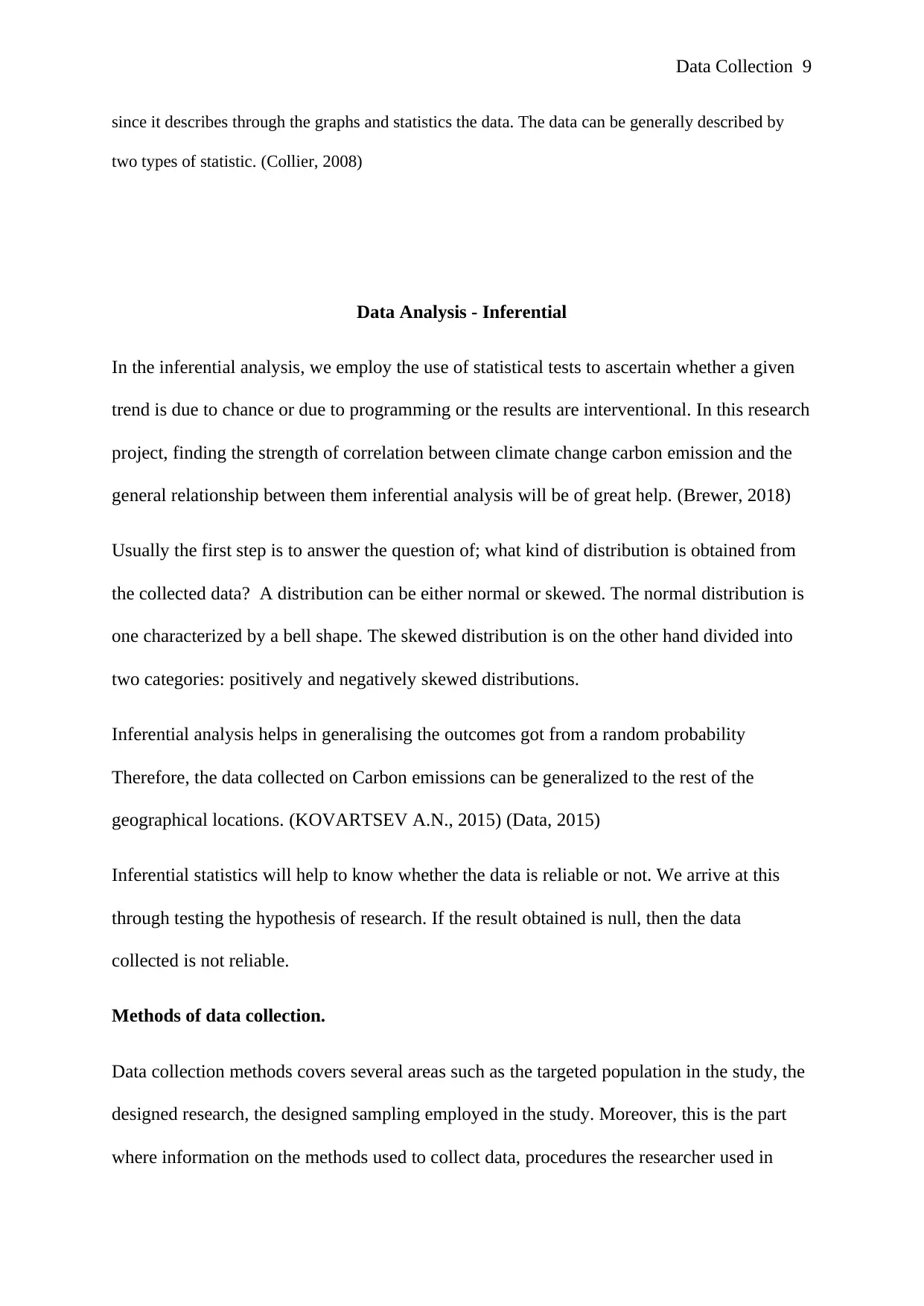
Data Collection 9
since it describes through the graphs and statistics the data. The data can be generally described by
two types of statistic. (Collier, 2008)
Data Analysis - Inferential
In the inferential analysis, we employ the use of statistical tests to ascertain whether a given
trend is due to chance or due to programming or the results are interventional. In this research
project, finding the strength of correlation between climate change carbon emission and the
general relationship between them inferential analysis will be of great help. (Brewer, 2018)
Usually the first step is to answer the question of; what kind of distribution is obtained from
the collected data? A distribution can be either normal or skewed. The normal distribution is
one characterized by a bell shape. The skewed distribution is on the other hand divided into
two categories: positively and negatively skewed distributions.
Inferential analysis helps in generalising the outcomes got from a random probability
Therefore, the data collected on Carbon emissions can be generalized to the rest of the
geographical locations. (KOVARTSEV A.N., 2015) (Data, 2015)
Inferential statistics will help to know whether the data is reliable or not. We arrive at this
through testing the hypothesis of research. If the result obtained is null, then the data
collected is not reliable.
Methods of data collection.
Data collection methods covers several areas such as the targeted population in the study, the
designed research, the designed sampling employed in the study. Moreover, this is the part
where information on the methods used to collect data, procedures the researcher used in
since it describes through the graphs and statistics the data. The data can be generally described by
two types of statistic. (Collier, 2008)
Data Analysis - Inferential
In the inferential analysis, we employ the use of statistical tests to ascertain whether a given
trend is due to chance or due to programming or the results are interventional. In this research
project, finding the strength of correlation between climate change carbon emission and the
general relationship between them inferential analysis will be of great help. (Brewer, 2018)
Usually the first step is to answer the question of; what kind of distribution is obtained from
the collected data? A distribution can be either normal or skewed. The normal distribution is
one characterized by a bell shape. The skewed distribution is on the other hand divided into
two categories: positively and negatively skewed distributions.
Inferential analysis helps in generalising the outcomes got from a random probability
Therefore, the data collected on Carbon emissions can be generalized to the rest of the
geographical locations. (KOVARTSEV A.N., 2015) (Data, 2015)
Inferential statistics will help to know whether the data is reliable or not. We arrive at this
through testing the hypothesis of research. If the result obtained is null, then the data
collected is not reliable.
Methods of data collection.
Data collection methods covers several areas such as the targeted population in the study, the
designed research, the designed sampling employed in the study. Moreover, this is the part
where information on the methods used to collect data, procedures the researcher used in
⊘ This is a preview!⊘
Do you want full access?
Subscribe today to unlock all pages.

Trusted by 1+ million students worldwide
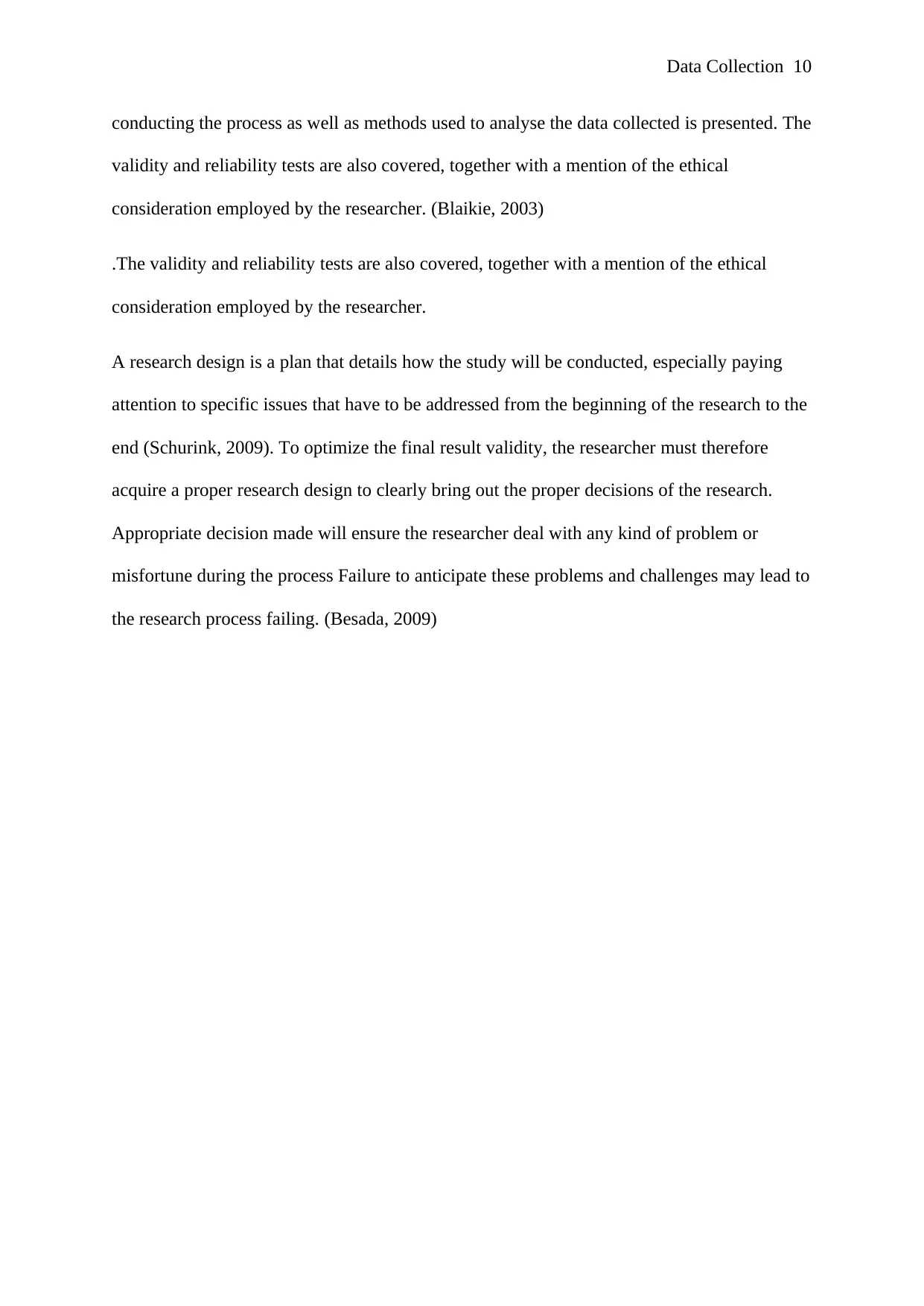
Data Collection 10
conducting the process as well as methods used to analyse the data collected is presented. The
validity and reliability tests are also covered, together with a mention of the ethical
consideration employed by the researcher. (Blaikie, 2003)
.The validity and reliability tests are also covered, together with a mention of the ethical
consideration employed by the researcher.
A research design is a plan that details how the study will be conducted, especially paying
attention to specific issues that have to be addressed from the beginning of the research to the
end (Schurink, 2009). To optimize the final result validity, the researcher must therefore
acquire a proper research design to clearly bring out the proper decisions of the research.
Appropriate decision made will ensure the researcher deal with any kind of problem or
misfortune during the process Failure to anticipate these problems and challenges may lead to
the research process failing. (Besada, 2009)
conducting the process as well as methods used to analyse the data collected is presented. The
validity and reliability tests are also covered, together with a mention of the ethical
consideration employed by the researcher. (Blaikie, 2003)
.The validity and reliability tests are also covered, together with a mention of the ethical
consideration employed by the researcher.
A research design is a plan that details how the study will be conducted, especially paying
attention to specific issues that have to be addressed from the beginning of the research to the
end (Schurink, 2009). To optimize the final result validity, the researcher must therefore
acquire a proper research design to clearly bring out the proper decisions of the research.
Appropriate decision made will ensure the researcher deal with any kind of problem or
misfortune during the process Failure to anticipate these problems and challenges may lead to
the research process failing. (Besada, 2009)
Paraphrase This Document
Need a fresh take? Get an instant paraphrase of this document with our AI Paraphraser
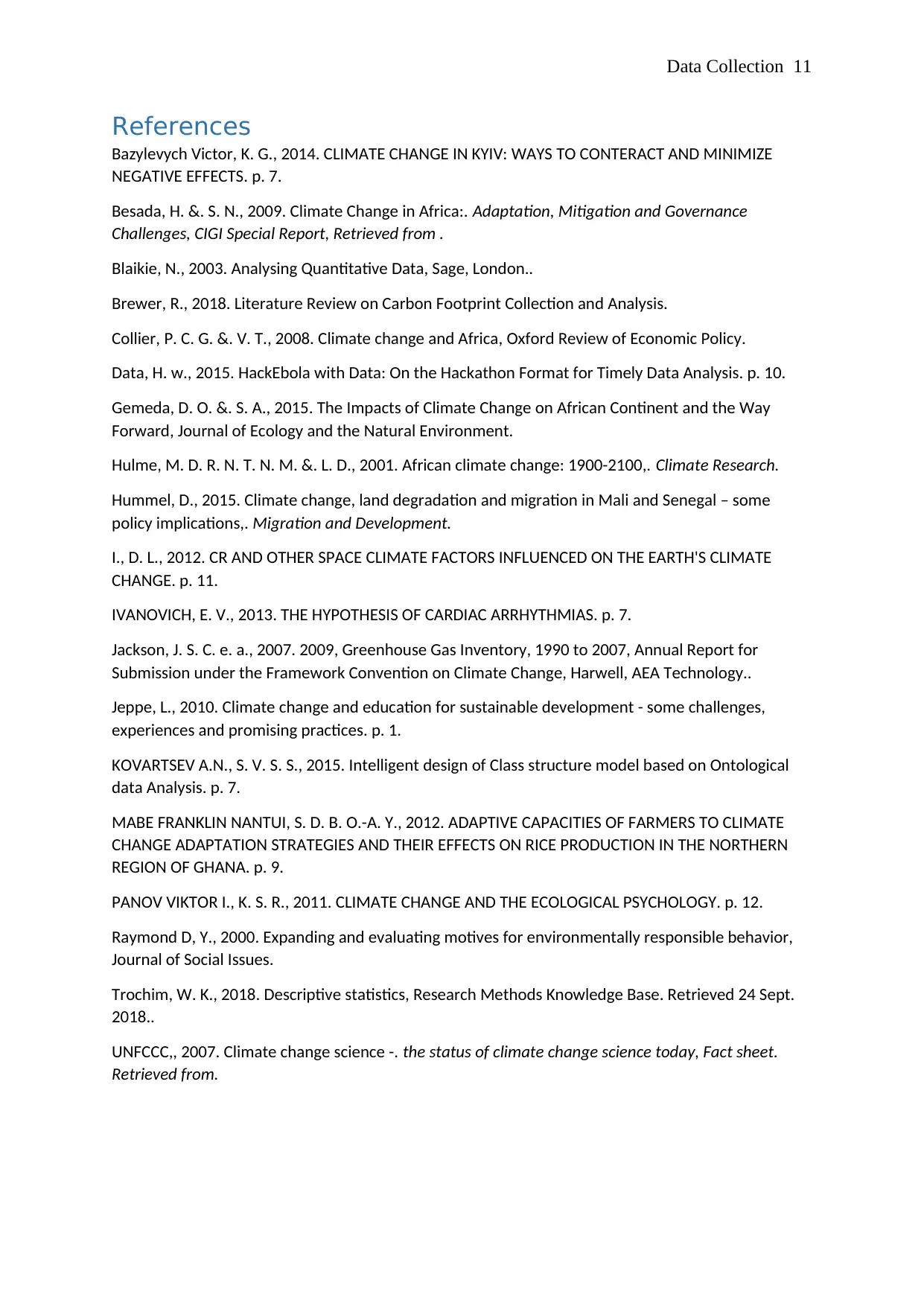
Data Collection 11
References
Bazylevych Victor, K. G., 2014. CLIMATE CHANGE IN KYIV: WAYS TO CONTERACT AND MINIMIZE
NEGATIVE EFFECTS. p. 7.
Besada, H. &. S. N., 2009. Climate Change in Africa:. Adaptation, Mitigation and Governance
Challenges, CIGI Special Report, Retrieved from .
Blaikie, N., 2003. Analysing Quantitative Data, Sage, London..
Brewer, R., 2018. Literature Review on Carbon Footprint Collection and Analysis.
Collier, P. C. G. &. V. T., 2008. Climate change and Africa, Oxford Review of Economic Policy.
Data, H. w., 2015. HackEbola with Data: On the Hackathon Format for Timely Data Analysis. p. 10.
Gemeda, D. O. &. S. A., 2015. The Impacts of Climate Change on African Continent and the Way
Forward, Journal of Ecology and the Natural Environment.
Hulme, M. D. R. N. T. N. M. &. L. D., 2001. African climate change: 1900-2100,. Climate Research.
Hummel, D., 2015. Climate change, land degradation and migration in Mali and Senegal – some
policy implications,. Migration and Development.
I., D. L., 2012. CR AND OTHER SPACE CLIMATE FACTORS INFLUENCED ON THE EARTH'S CLIMATE
CHANGE. p. 11.
IVANOVICH, E. V., 2013. THE HYPOTHESIS OF CARDIAC ARRHYTHMIAS. p. 7.
Jackson, J. S. C. e. a., 2007. 2009, Greenhouse Gas Inventory, 1990 to 2007, Annual Report for
Submission under the Framework Convention on Climate Change, Harwell, AEA Technology..
Jeppe, L., 2010. Climate change and education for sustainable development - some challenges,
experiences and promising practices. p. 1.
KOVARTSEV A.N., S. V. S. S., 2015. Intelligent design of Class structure model based on Ontological
data Analysis. p. 7.
MABE FRANKLIN NANTUI, S. D. B. O.-A. Y., 2012. ADAPTIVE CAPACITIES OF FARMERS TO CLIMATE
CHANGE ADAPTATION STRATEGIES AND THEIR EFFECTS ON RICE PRODUCTION IN THE NORTHERN
REGION OF GHANA. p. 9.
PANOV VIKTOR I., K. S. R., 2011. CLIMATE CHANGE AND THE ECOLOGICAL PSYCHOLOGY. p. 12.
Raymond D, Y., 2000. Expanding and evaluating motives for environmentally responsible behavior,
Journal of Social Issues.
Trochim, W. K., 2018. Descriptive statistics, Research Methods Knowledge Base. Retrieved 24 Sept.
2018..
UNFCCC,, 2007. Climate change science -. the status of climate change science today, Fact sheet.
Retrieved from.
References
Bazylevych Victor, K. G., 2014. CLIMATE CHANGE IN KYIV: WAYS TO CONTERACT AND MINIMIZE
NEGATIVE EFFECTS. p. 7.
Besada, H. &. S. N., 2009. Climate Change in Africa:. Adaptation, Mitigation and Governance
Challenges, CIGI Special Report, Retrieved from .
Blaikie, N., 2003. Analysing Quantitative Data, Sage, London..
Brewer, R., 2018. Literature Review on Carbon Footprint Collection and Analysis.
Collier, P. C. G. &. V. T., 2008. Climate change and Africa, Oxford Review of Economic Policy.
Data, H. w., 2015. HackEbola with Data: On the Hackathon Format for Timely Data Analysis. p. 10.
Gemeda, D. O. &. S. A., 2015. The Impacts of Climate Change on African Continent and the Way
Forward, Journal of Ecology and the Natural Environment.
Hulme, M. D. R. N. T. N. M. &. L. D., 2001. African climate change: 1900-2100,. Climate Research.
Hummel, D., 2015. Climate change, land degradation and migration in Mali and Senegal – some
policy implications,. Migration and Development.
I., D. L., 2012. CR AND OTHER SPACE CLIMATE FACTORS INFLUENCED ON THE EARTH'S CLIMATE
CHANGE. p. 11.
IVANOVICH, E. V., 2013. THE HYPOTHESIS OF CARDIAC ARRHYTHMIAS. p. 7.
Jackson, J. S. C. e. a., 2007. 2009, Greenhouse Gas Inventory, 1990 to 2007, Annual Report for
Submission under the Framework Convention on Climate Change, Harwell, AEA Technology..
Jeppe, L., 2010. Climate change and education for sustainable development - some challenges,
experiences and promising practices. p. 1.
KOVARTSEV A.N., S. V. S. S., 2015. Intelligent design of Class structure model based on Ontological
data Analysis. p. 7.
MABE FRANKLIN NANTUI, S. D. B. O.-A. Y., 2012. ADAPTIVE CAPACITIES OF FARMERS TO CLIMATE
CHANGE ADAPTATION STRATEGIES AND THEIR EFFECTS ON RICE PRODUCTION IN THE NORTHERN
REGION OF GHANA. p. 9.
PANOV VIKTOR I., K. S. R., 2011. CLIMATE CHANGE AND THE ECOLOGICAL PSYCHOLOGY. p. 12.
Raymond D, Y., 2000. Expanding and evaluating motives for environmentally responsible behavior,
Journal of Social Issues.
Trochim, W. K., 2018. Descriptive statistics, Research Methods Knowledge Base. Retrieved 24 Sept.
2018..
UNFCCC,, 2007. Climate change science -. the status of climate change science today, Fact sheet.
Retrieved from.

Data Collection 12
⊘ This is a preview!⊘
Do you want full access?
Subscribe today to unlock all pages.

Trusted by 1+ million students worldwide
1 out of 12
Your All-in-One AI-Powered Toolkit for Academic Success.
+13062052269
info@desklib.com
Available 24*7 on WhatsApp / Email
![[object Object]](/_next/static/media/star-bottom.7253800d.svg)
Unlock your academic potential
Copyright © 2020–2025 A2Z Services. All Rights Reserved. Developed and managed by ZUCOL.